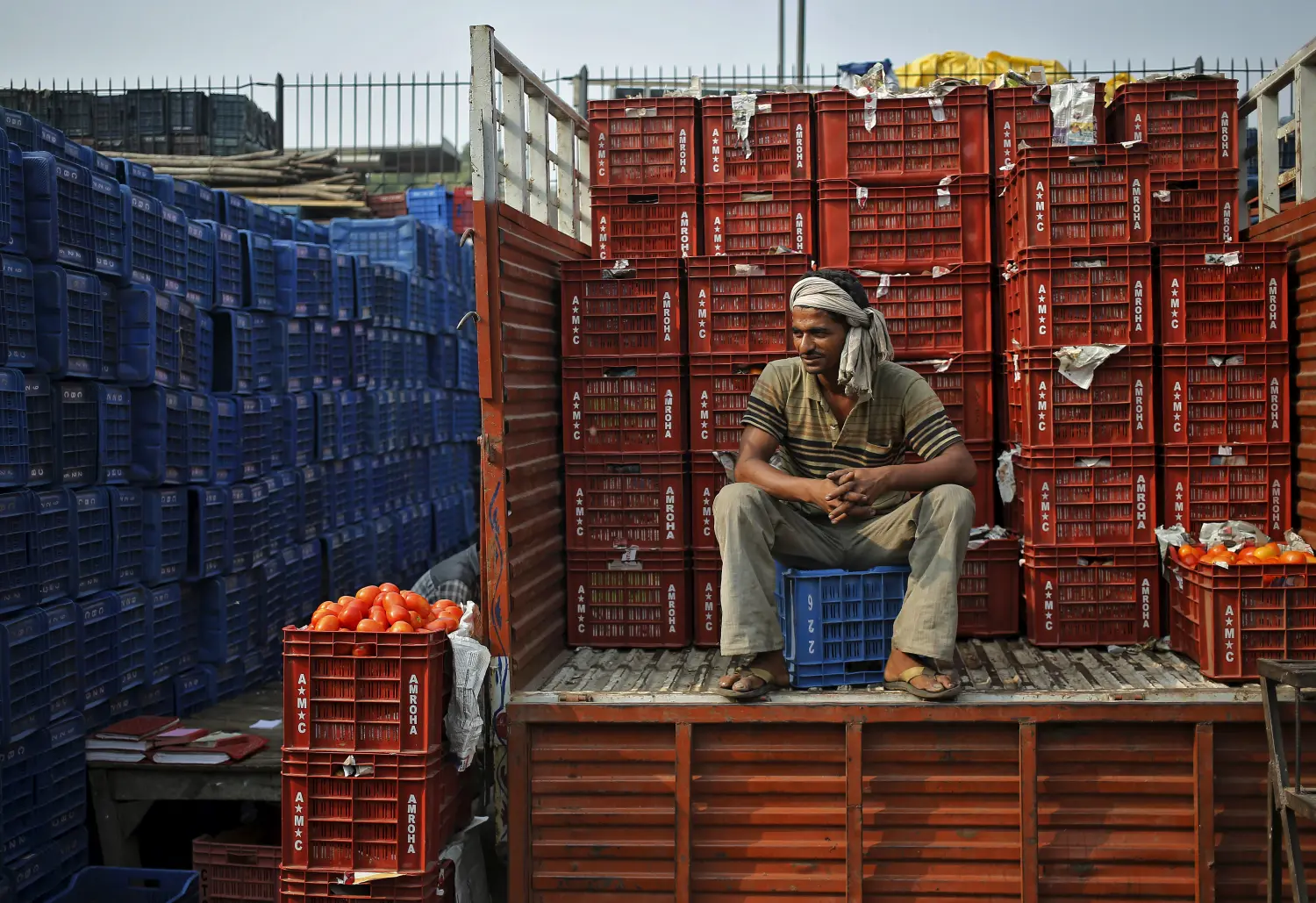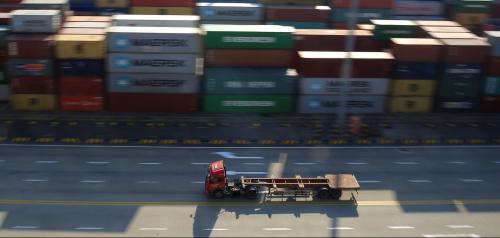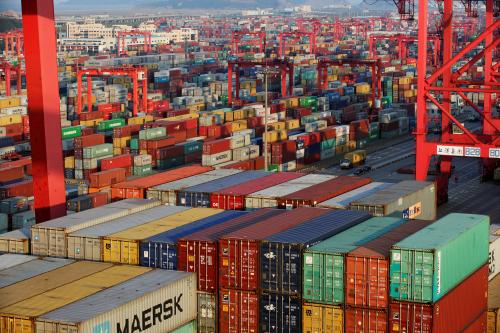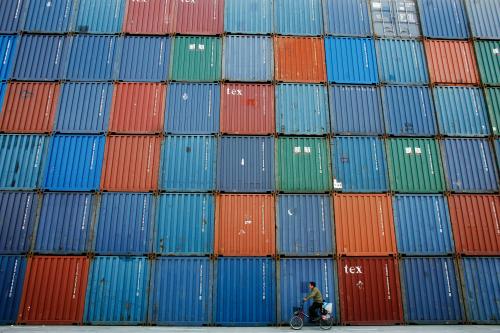Content from the Brookings Institution India Center is now archived. After seven years of an impactful partnership, as of September 11, 2020, Brookings India is now the Centre for Social and Economic Progress, an independent public policy institution based in India.
Following is a concise summary of the paper covering the various aspects of the paper. To download the Complete Working Paper click here
SUMMARY: This paper discusses India’s trade policy reform since 1991, providing quantitative information and qualitative insights regarding the evolution of trade policy in the past 25 years. The Finance Minister in his 1991 Union Budget speech explicitly stated that trade policy reform was an important part of the economic reform initiated by India in 1991. Trade policy reform since then is a journey that transformed not just India’s trade policy framework, but also the evolution of several domestic policies.
download the complete working paper
The extent of change needed and achieved by India shows that this was a difficult transition. However, this change was managed with much less disruption than in many other countries which carried out as significant a policy reform as India has done since 1991. Two-and-a-half decades ago, India was a country with very high tariffs, multiple and complex systems of control on both imports and exports, and exchange rate controls that had created an economic situation where “ease of doing business” was not a significant priority. Trade policy was considered as a tool of industrial policy within a system of extensive controls which created time-consuming multiple layers of decision-making and delays, and increased costs which affected trade, investment and the efficiency of domestic operations. The reform of this system initiated in 1991 was a huge task and required a clear specification of the path towards a more transparent and less complex system, with reduced controls and established less ad-hoc policy framework, as India moved towards more open markets.
A Long Journey Covered, But Trade Policy Reform Still An Unfinished Agenda
This paper provides some detail of India’s trade policy reform since 1991, based on data as well as insights from some key policy statements highlighting the objectives of the Government. The scope of the subject matter is huge, and scholars may wish to conduct deeper work on various issues. Thus, the paper has been written describing the trade policy experience of India, as well as facilitating those who wish to study the issues in greater detail. Therefore, this paper is a tool for both better understanding the various areas covered, and enabling analysts to update the information or examine it in greater detail.
The paper notes a number of traditional trade policy areas where the reform agenda remains unfinished and needs further attention. For instance, it points out that some parts of the reform agenda highlighted by the Chelliah Committee Report to the Government in 1993 still remain valid. Moreover, the paper shows that the coverage and the content of trade policy has been increasing over time, which implies that the task of trade policy reform will remain a continuing one, rather a finished agenda.
A Significant New Insight
An important new insight from the paper is that India is in fact a far more open economy than is perceived in general. This paper shows that the applied average tariffs of India are far lower than is commonly considered. In fact, India’s applied average tariffs are quite close to that of the United States, which is considered to be a low tariff economy.
This shows that the conventional view that India is a country with relatively high tariff barriers needs to be revised. An appreciation of this reality would pave the way towards both simplifying and improving transparency of the present tariff regime, and developing a new trade negotiation strategy for India.
Summary of the key parts addressed by the paper
The paper begins with a summary look at some key economic aggregates since 1991. We can see that today India faces a much more favourable situation than in 1991, though with a high trade deficit. This trade deficit colours the perspective of both the Indian policy makers and the industry when they consider international trade policy issues.
This paper introduces the discussion on trade policy reform by introducing the broad thrust of the trade policy reform as explained in the 1991 Budget speech. It also gives the underlying vision of trade policy reform as explained in some detail in the Budget speech of 1993. The Annex reproduces the 1993 speech as well as short passages from the Budget speeches from other years to shed light on the focus of trade policy reform under different Finance Ministers over time. A noteworthy feature in this context is that trade policy reform was continued by every Government that came to power, both in the conventional areas of trade policy, as well as in the new areas of trade policy that have emerged in the last 25 years. This paper discusses these developments, identifying both the significant progress made through reform and a number of areas where further progress is required.
Tariffs: While the main elements of tariff reform were specified in the 1991 Budget, this effort was supplemented by the report of an expert committee under Prof. Raja Chelliah. The paper provides a brief summary of this committee’s recommendations, which inter alia provided a roadmap for tariff reductions and simplification of the tariff regime. As mentioned above, some of the ideas in that Report are still unfinished business and are worth consideration.
Supplemented by recommendations of the expert committee, India’s trade policy reform paved the road for a major reduction of average tariffs, tariff peaks, simplification of the tariff and quota regimes, and removal of several import restrictions. These changes reflected a larger vision of reform to enhance the efficiency of domestic industry, together with a number of other objectives such as promoting infant industry, exports, technological upgradation and food security.
In 1991, India’s peak tariffs were reduced to 150 per cent and over time, India’s peak tariffs have been brought down to 10 per cent ; the term “peak tariffs” in India refers to the tariff rate that applies in general to most tariff lines (nearly three-quarter tariff lines), and excludes agriculture tariffs. The highest agriculture tariff remains 150 per cent (on mainly alcohol), but this tariff applies to a very minuscule percentage of the overall tariff lines. Bulk of the tariff lines (86 per cent) are “non-agriculture”, where 90 per cent of the tariff lines are between zero and 10 per cent.
India’s tariff reduction led to the simple average tariffs for India in 2015-16 being only about one-tenth that of the level in 1990-91. As mentioned above, the average applied tariffs of India are even lower, close to the estimates for those economies that are considered very low tariff economies.
The average tariff decline has been accompanied by a reduction in the spread of the range of tariffs, and the tariff regime being much simpler than it was in 1991. The tariff inversion (lower tariffs on processed products in comparison to semi- processed or unprocessed products) has been largely corrected, and the tariff regime is considerably less arbitrary today. However, in all these areas, the process of reform is still not complete and there is scope to further improve the situation. This possibility becomes even more tangible and feasible when we consider the fact that there is a significant gap between the announced tariffs and the actual applied tariffs.
While the reduction in tariffs has been a large one since 1991, the actual impact on domestic producers was somewhat mitigated for quite some time due to the devaluation/depreciation of the domestic currency. The paper shows this aspect, and also discusses the different trajectories of India’s nominal and real effective exchange rates. The real effective exchange rate shows that despite the large fall in the nominal effective exchange rate, the competitive situation for India has not changed much.
Non-tariff measures: The paper next discusses non-tariff measures, in particular those which are more frequently used. These include quantitative restrictions, antidumping measures, and sanitary phytosanitary (SPS) and technical barriers to trade (TBT) measures.
Quantitative restrictions (QRs) are imposed not only for protectionist purposes, but also for objectives such as health and safety reasons, technical compatibility of requisite standards, moral reasons, environmental reasons, or to meet obligations under international agreements: these objectives are recognised as being “justifiable” under the WTO rules.
India has reduced its QRs over time from the complex and extensive regime of 1991 to one with much lower coverage, with simpler procedures and lower incidence. The QRs today are to mainly to meet the “justifiable” objectives, and the regime is more simple and transparent. However, as in the case of tariffs, the reform process still has scope for further improved governance with greater predictability and transparency. This is not unusual or specific to India. Non-tariff measures are the new area of focus where reform is needed in many economies, large and small.
India is the second-highest user of anti-dumping, second only to the United States. Interestingly, with the reduction of tariffs, the use of anti-dumping has increased. This is a phenomenon seen in many countries that have rationalized their trade policies and reduced their tariff levels in general. However, this policy area would need continued attention and a process which enmeshes anti-dumping provisions with the emphasis on facilitating trade procedures for ease of doing business and reducing avoidable costs for consumers, industries using imported inputs, and exports from India.
Anti-dumping measures are part of the group of “contingency measures” against imports which include countervailing (or anti-subsidy) and safeguards measures as well. Each contingency measure is chosen for reasons relevant for imposing an import restriction, which may be used to address dumped imports, subsidized imports, or rise in import penetration causing material or serious injury to domestic industry. An important gap in the case of contingency measures (particularly, safeguards) has been that India needs to work on bringing in place regulations or amendments to its law to impose contingency protection measures under FTAs. This is particularly important in the background of several concerns having ben expressed in recent years with respect to FTAs.
SPS and TBT measures are collectively referred to as “standards”. These measures are far more pervasive than any other non-tariff measure, but the trade policy concern relates only to standards which are protectionist (in general, standards are required to implement the objectives such as health and safety, technical compatibility, or environmental concerns) . Protectionist use may arise in terms of the content or the process of acceptance of the standard. This in turn is linked to policies or procedures being non-arbitrary, transparent and simplified, and facilitating timeliness..
In addition, specific efforts are needed to improve the capacity of domestic firms to meet the requisite standards. Significantly, standards required to be met in the market, particularly for international supply chains, are not only those stipulated by the government, but also private standards whose significance has been increasing over time. Standards in the context of trade thus cover policy related issues, private standards and their proliferation, and the capacity of the domestic producers to meet the relevant conditions for their products to be accepted as being compatible with the requisite standard.
India has made major progress in these areas, with co-ordinated initiatives that have brought all standards-related stakeholders on a common platform, developed a road-map for policy and for enhancing capacity of domestic firms and institutions, and paved the way for agreements that help products being accepted in other markets. The paper mentions some of these major initiatives, and compares India’s standards policy as viewed in the WTO with the situation for some other major economies.
The incidence and importance of standards is increasing, and both policy makers and business need to be more attentive and collaboratively involved in building the conditions that will facilitate efficient and supportive standards related policies.
Services Trade
Compared to goods, services trade policy issues and related disciplines have been considered much later in time. Services became significant in overall global trade, with the growth of international supply chains and improvements in communications and transport technology. It is noteworthy that a very important complementary policy for services is the corresponding regulatory regime. The growth of services trade has also meant an increasing role of regulatory policies (and thus of domestic policies) in trade. In addition, the discussion on services trade led to a wider framework encompassing different ways of carrying out international trade, including for example the service provider travelling to the importing market or FDI being made in the importing market to provide services exports. Several services contribute to improving competitiveness, with large multiplier impact on economic activities. Hence, effectively implementing policy reform on the policies discussed earlier in the context of goods, e.g. standards. Therefore, policies that improve the performance of services assume major importance.
In this background, this paper points out a number of areas where action is required to improve services related trade policies for India.
Trade Facilitation
A very important trade policy development has been a shift in focus from trade restriction towards trade facilitation. This perspective is important in a world with growing levels of competitiveness and increasing significance of international value or supply chains, which require cost-effective and timely procedures for imports and exports. The most recent manifestation of this emphasis has been the Trade Facilitation Agreement (TFA) agreed at the WTO.
Interestingly, India embarked on its journey to improve trade facilitations several years before trade facilitation became an important trade policy area in bilateral and multilateral discussions. After the TFA, however, India has intensified its efforts for implementing trade facilitation policy in a major co-ordinated manner. The paper covers these aspects, including the current efforts of India in this area.
Other Emerging Trade Policy Issues
The paper raises a number of emerging trade policy issues, including those related to the digital platform, greater use of informal mechanisms in trade, the need to acquire technologies at a time when the technological paradigm is changing or when global concerns like environment require a re-look at conditions of transfer of technology, need for regulatory coherence, issues relating to investment and competition policy, exchange rate policy, jobs and small and medium enterprises (SMEs) together with ways of enhancing collaborative activities to improve the potential of SMEs, and greater attention to addressing the possibility of standards or support to state enterprises as mechanisms being used to tilt the “level playing field” in international trade.
Conclusion
In its conclusion, the paper notes the considerable trade policy reform that has taken place in India since 1991, and then summarises a number of areas for further reform or improvement. It emphasizes a need for adopting trade policies in a co-ordinated manner, to simplify procedures, make them more transparent, and reduce arbitrariness. In this process, policy makers need to consider trade policy and domestic policy in an integrated manner, keeping in mind the continuing evolution of trade policy, emergence of new market conditions, and the growth of both formal and informal mechanisms which determine the opportunities and constraints in the global markets.
This also implies that the governance mechanisms for trade policy and trade negotiations would need to have an over-arching perspective and reach with timely, informed and interactive consideration of various issues. A new approach, using the tools of new technology and a large database that is shared commonly amongst the governance agencies, would need to be developed.
Further, the developments due to the emergence of disruptive technologies, evolution of social and sustainability considerations, and the tendency of policy issues to spill over into the practices of private sector lead firms in global value chains, imply that the policy maker has to not only work with a much wider agenda than earlier but also interact much more closely with the private sector than is the conventional practice.
A new approach, new institutional mechanisms and far-reaching integrated initiatives are thus needed for sustaining the momentum of the immense trade policy reform that has been achieved by India since 1991.










